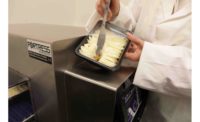Supporting Sustainability: Helping food factories make mindful food inspection choices

Embracing sustainability is a smart business move. Especially in food production, where the effects of waste, energy consumption and resources ripple out to consumers in mainstream society, influencing their decision making process.
For Gen Z especially, environmental stewardship is especially prevalent. With Millennials now making up one fourth of the planet’s population[i], their spending power will have a marked impact on the future consumer landscape. Characteristically, Millennials value convenience. Yet, they also want to be more informed about business practices, with 81 percent also wanting to know the backstory of where their food has come from[ii]. Unlocking this Millennial mindset could be the key to manufacturers achieving circular infrastructure success, believes food inspection specialist Fortress Technology.
As a Millennial business itself - Fortress was incorporated in 1996 - the company’s founding principles performance, reliability, simple operation and Never Obsolete Commitment continue to assist food producers the globe over to raise their sustainability game.
Fortress believes that choosing more sustainable production methods requires a multi-pronged approach. With 90% of Fortress metal detectors sold to food factories, extending the lifespan of equipment and optimizing Return on Investment (ROI) is one way keep your sustainability stakeholders happy.
“Many larger food producers today are finding themselves under pressure from investors to provide hard evidence of sustainable actions,” highlights Fortress President Steve Gidman. “It means you can’t just claim to be sustainable; you have to prove and rubber stamp it.”
For food manufacturers, demonstrating, let alone quantifying sustainability is often the greatest challenge. Even the word itself means different things to different generations, from environmentally friendly to organic, ethical to transparency. Another challenge is the split about what constitutes sustainability between consumers and industry. This is in part due to the fact there are so many aspects to the agenda – from being eco-friendlier by reducing energy consumption and your carbon footprint, to tackling the volume of food that ends up in landfill.
A lasting legacy
Most electronics and industrial machines today are not designed to last forever, let alone be upgradeable. Components are glued to motherboards. Smartphones are sealed. Digital control panels are discarded when the pixel dies. The waste generated is enormous, and the ecological footprint even bigger. If thrown into a landfill, hazardous substances can leak out causing soil and water contamination. This can be harmful to wildlife and to human health.
It’s estimated that the United States produces as much as 7.6 billion tons of industrial waste annually. Disposing of out-moded industrial food production assets can be especially complex. It usually requires the support of specialist organizations. Because most metal detectors have coils embedded within them, this makes it even harder to reclaim and recycle components when a machine enters the waste stream.
Reassuringly, with the right maintenance, a well-built food metal detector can run for 20+ years. Machinery innovation isn’t going to slow. There’s always going to be faster, more efficient and cutting edge technological solutions coming to market. But that doesn’t mean prematurely discarding perfectly functional kit/machinery because it doesn’t comply with the latest retail inspection standards or regulations.
From the outset, all Fortress technology parts developed have been designed with backward compatibility in mind. Down to the search head, parts can be replaced with the latest greatest revision of a part, or a metal detector could even be upgraded to a newer model. Just last year, one of the first machines ever sold by the company was upgraded from an analog metal detector with no digital controls to the current Stealth hardware platform. This legacy metal detector continues to run as efficiently as the day it was installed in 1996. However, it now has the latest hardware and software features of the Fortress Stealth.
Reshaping the circular economy
Creating an economy that is regenerative, resilient, and fit for the long term, reinforces the Fortress philosophy. Since inception, the company has focused a significant amount of R&D effort into designing and deploying Never Obsolete metal detectors. It is now the company’s unique selling point, valued by every single customer.
To help food factories shift from a ‘take, make and dispose’ business model, last year Fortress re-launched its flagship Phantom metal detector. Now, when future production requirements and retailer codes of practice demand it, the entry level offering can be upgraded to include the data capture specifications and expandable I/O with the company’s preceding Stealth model.
To support flexible production and provide smarter machine monitoring, the company introduced a simple method that enables food factories to monitor the performance of a fleet of metal detectors. Believed to be the first-of-its kind web-based inspection machine browser, Remote Management Software (RMS) connects multiple Fortress metal detectors by utilizing machine-to-machine (M2M) communication over LAN.
An unlimited number of Fortress metal detectors can be connected wirelessly using a powerful back-end SQL to monitor activity real time via web friendly interface and generate reports exportable in either PDF or Excel formats.
RMS is available as an option on all Fortress Stealth metal detectors. It is installed on the Interceptor range as standard. In keeping with Fortress’s ‘Never Obsolete’ commitment, existing Stealth metal detectors in the field can also have software upgraded to connect with existing compatible Stealth metal detectors.
More food for thought
International initiatives like SAVE FOOD have helped to firmly place the issue of food loss on the political agenda. Across the entire value chain, there has been a concerted effort to address people’s throwaway mindset.
Roughly one third of the food produced in the world annually for human consumption— approximately 1.6 billion tons — gets lost or wasted. That’s enough to meet future global food needs. Arguably, food waste is where the most obvious sustainability agenda lies.
The challenge right now is production processes typically focus more on optimizing equipment availability and line speeds rather than implementing KPIs to measure food waste. Excessive levels of false rejects are one area where food manufacturers can benefit from the most recent metal detector innovations.
Fortress estimates that false product rejects may add up to over $14,000 for each food line, depending on the scale of the problem. The Interceptor range helps to tick this sustainability box by addressing the issue of product effect that’s more prevalent in wet or conductive products like meat, dairy and baked bread.
Critically, false rejects don’t just impact the physical waste where good food is discarded. Lower factory yield can undermine the cost-effectiveness of an entire operation, while repeated stoppages and trouble-shooting will incur unnecessary cost.
Concluding, Steve says: “Sustainability cannot be considered on a single metric alone. However, there's much to be said, from many environmental vantage points, about postponing replacement purchases of anything, not just metal detectors. If food production facilities can keep machinery out of the waste stream and delay the additional environmental costs of making something new, that’s responsible waste stewardship. It’s also a big tick for every manufacturer who is striving to achieve their sustainability goals.”
Looking for a reprint of this article?
From high-res PDFs to custom plaques, order your copy today!





